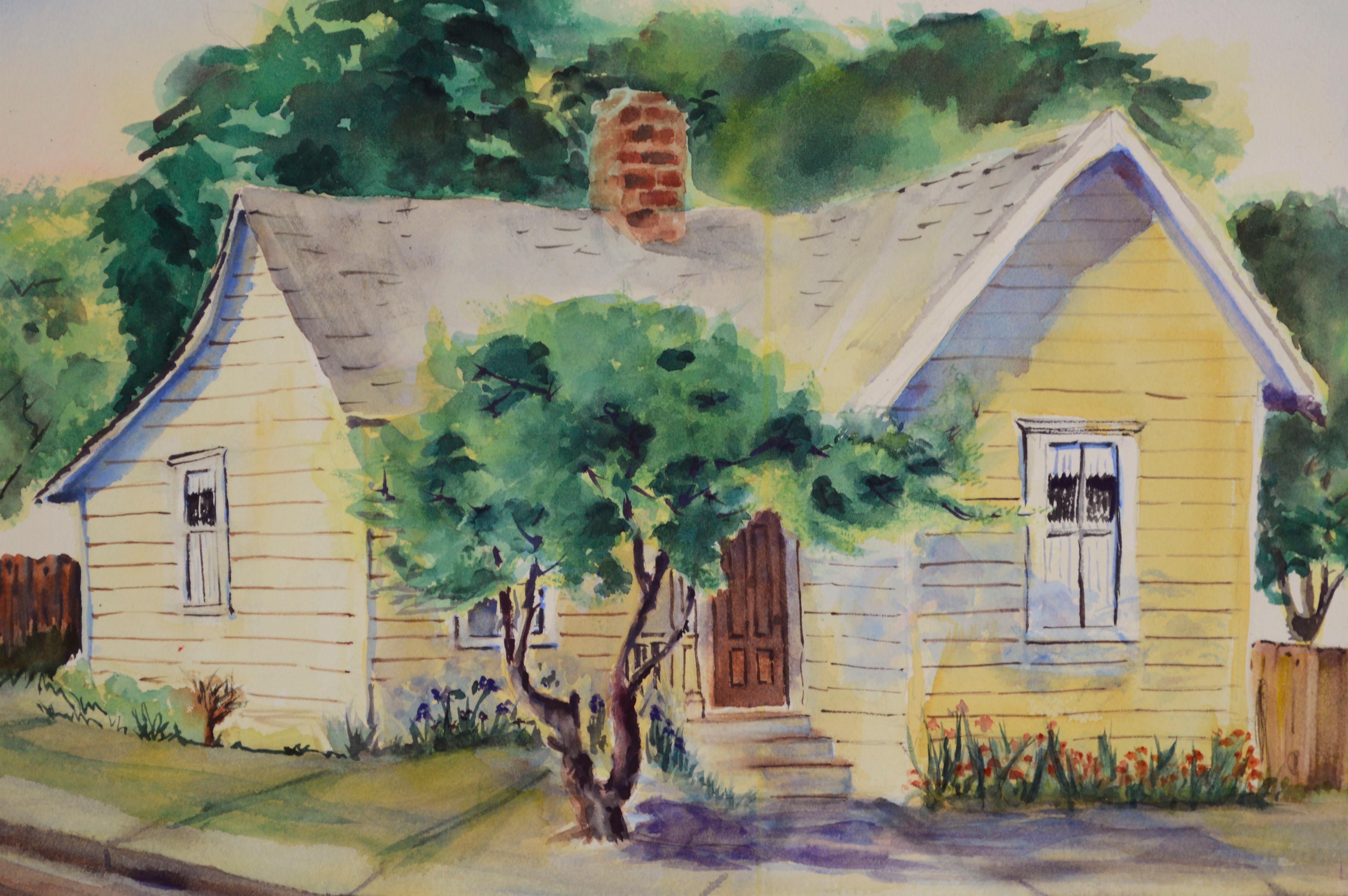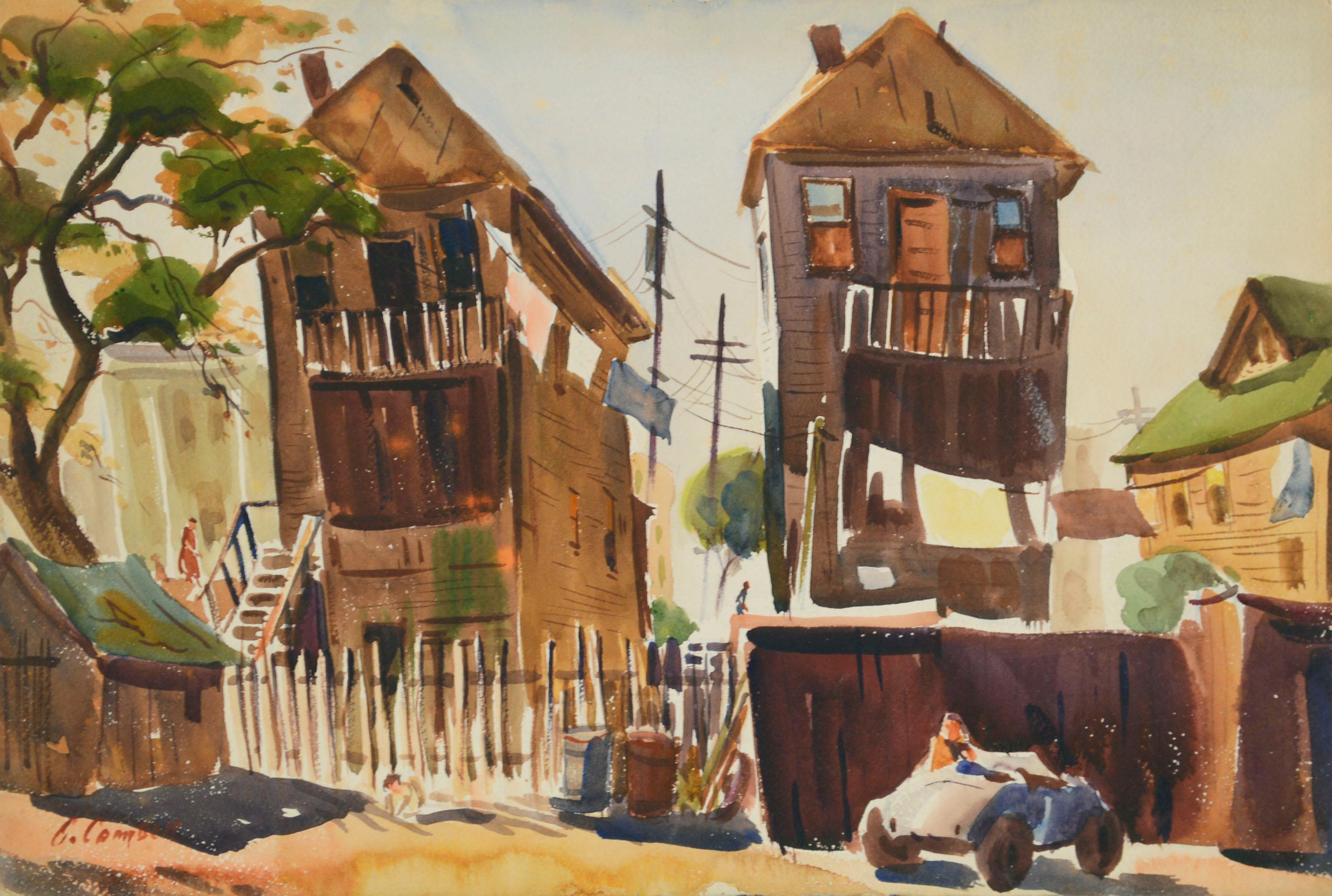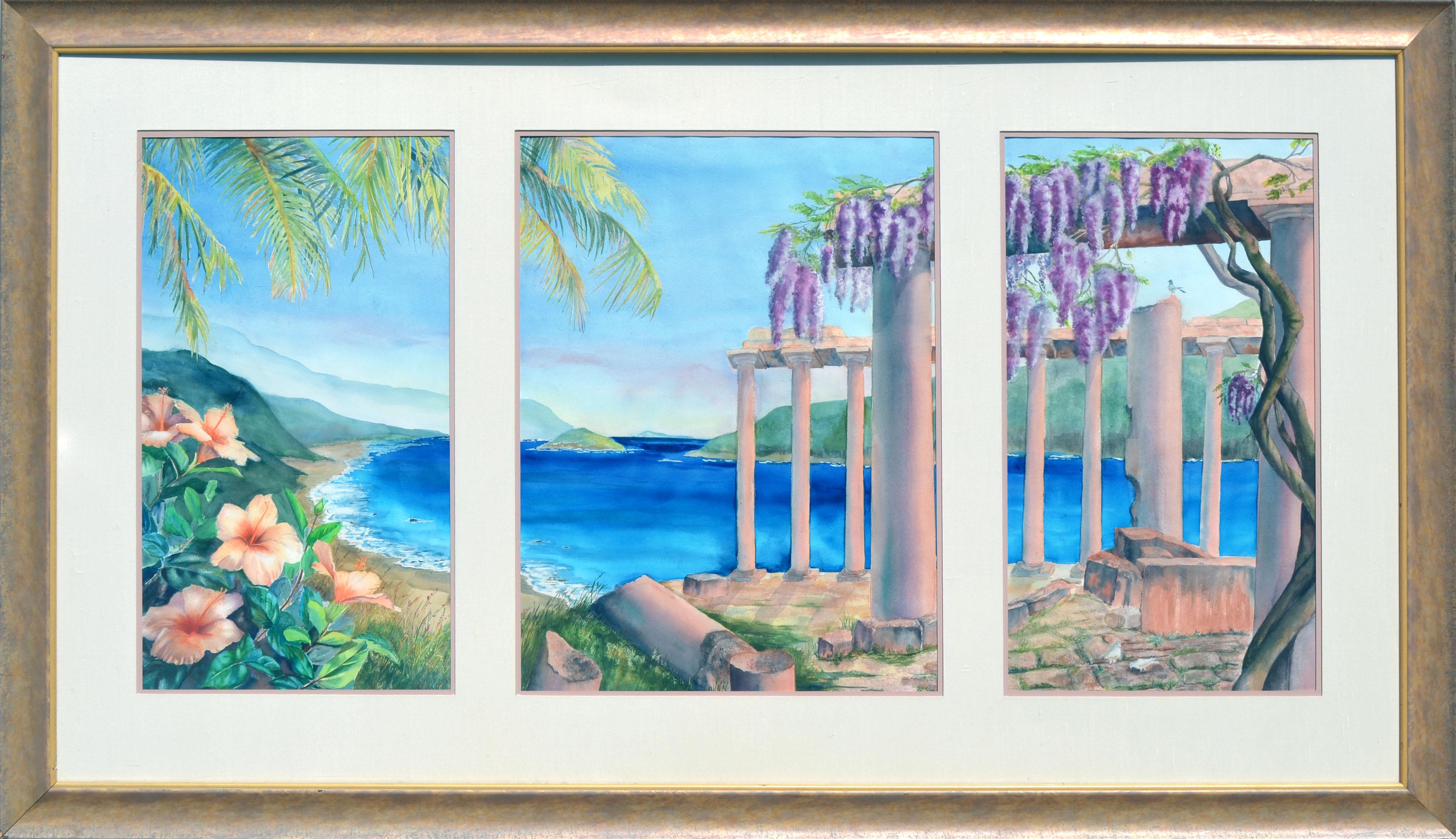Items Similar to Boats Along the Shore - Coastal Seascape in Watercolor on Paper
Want more images or videos?
Request additional images or videos from the seller
1 of 13
Jack GarverBoats Along the Shore - Coastal Seascape in Watercolor on Paperlate 20th Century
late 20th Century
About the Item
Serene seascape by Jack Garver (American, b. 1925). Boats are tied up just off shore, along a sweeping, sandy coastline. Trees and structures can be seen along the coast, just beyond the beach. Puffy clouds partially fill the blue sky above.
Signed "jack garver" in the lower left corner.
Presented in a wormwood frame with a linen liner.
Frame size: 20"H x 27"W
Image size: 13.5"H x 20.5"W
Jack Garver (American, b. 1925) is a member of the American Watercolor Society, Salmagundi Club, Watercolor U.S.A., Honor Society, and many regional art organizations. He holds a Bachelor of Fine Arts degree from Carnegie Tech (now Carnegie Mellon University). A native of Maryland, he began his teaching career in Baltimore heading the art department of Gilman School for 15 years. He then chaired the art department at The Lawrenceville School in New Jersey for 23 years. In both schools he taught art history as well as studio courses. While in Baltimore, he also taught stage production and design at Goucher College.
His watercolors have been exhibited throughout the Unites States and have won many national honors including awards from the Salmagundi Club, Water color U.S.A., Adirondacks Watercolor Annual, American Artists Professional League, Mystic Maritime International, and the Georgia, Louisiana, Taos, New England, and Pittsburgh Watercolor Societies. In 1999 his work was chosen among the “top 100” in the annual “Arts for the Parks” competition. He has had more than a score of one-man shows, and his watercolors are included in hundreds of private and corporate collections here and abroad.
Garver was featured in the December ’81 and July ’02 issues of American Artist magazine. More than thirty of his paintings have been selected for publication as greeting card and calendar subjects. As of 2011, the Garvers were living on Cape Cod where Jack continues to paint (drawing largely upon his travels for inspiration), teach adult classes, and lecture on art history.
- Creator:Jack Garver (1925, American)
- Creation Year:late 20th Century
- Dimensions:Height: 20 in (50.8 cm)Width: 27 in (68.58 cm)Depth: 1.25 in (3.18 cm)
- Medium:
- Movement & Style:
- Period:
- Condition:Some tonal ageing to paper. Frame is vintage and shows signs of wear, including discoloration of linen.
- Gallery Location:Soquel, CA
- Reference Number:
About the Seller
4.9
Platinum Seller
These expertly vetted sellers are 1stDibs' most experienced sellers and are rated highest by our customers.
Established in 1986
1stDibs seller since 2014
2,541 sales on 1stDibs
Typical response time: <1 hour
- ShippingRetrieving quote...Ships From: Soquel, CA
- Return PolicyA return for this item may be initiated within 14 days of delivery.
More From This SellerView All
- Show Me Home - Double Sided WatercolorBy Les AndersonLocated in Soquel, CAA beautiful double sided watercolor painting of a vibrant yellow house surrounded by green trees with a landscape painting of houses on the green hillside with faded mountaintops in ...Category
Mid-20th Century American Impressionist Landscape Paintings
MaterialsWatercolor, Paper
- Finding My Way Home, Mid Century Pacific Grove Watercolor LandscapeLocated in Soquel, CAA charming impressionist Pacific Grove, California townscape with a man driving along with houses by C. Campbell. Signed "C. Campbell" lower left. Unframed. Image, 14"H x 21"L.Category
21st Century and Contemporary American Impressionist Landscape Paintings
MaterialsWatercolor, Paper
- Minimalist Mid Century Modern Landscape -- Autumn TreesLocated in Soquel, CAMinimalist mid-century modern landscape of three autumnal trees by M. Lehtio (American, 20th century). Signed "M. Lehtio" and dated "48." Presented in a wood frame and non-glare glas...Category
1940s American Impressionist Landscape Paintings
MaterialsWatercolor, Laid Paper
- Mid Century Tonalist Landscape of California Country RoadLocated in Soquel, CABeautiful tonalist landscape of California foothills and country road. Signed and dated "CKP" and "'69" lower right corner. Presented in rustic wood frame with eggshell mat under nonglare glass. Image size: 18.25"H x 13.25"W. Framed size: 23.5"H x 18"W. California Tonalism was art movement that existed in California from circa 1890 to 1920. Tonalist are usually intimate works, painted with a limited palette. Tonalist paintings are softly expressive, suggestive rather than detailed, often depicting the landscape at twilight or evening, when there is an absence of contrast. Tonalist paintings could also be figurative, but in them, the figure was usually out of doors or in an interior in a low-key setting with little detail. Tonalism had its origins in the works of the French Barbizon school and in the works of American painters who were influenced by them. California Tonalism was born when the emphasis in California landscape painting passed from the grand landscapes of works like those of Thomas Hill and William Keith's early career, to more intimate views of a domesticated landscape. At the same time, the parallel Pictorialist Photography...Category
1960s American Impressionist Landscape Paintings
MaterialsGouache, Laid Paper
- Large Scale Triptych Watercolor Landscape -- Paradise CoveLocated in Soquel, CAA secluded ancient site with lush foliage overlooking a brilliant blue cove is the subject of this watercolor triptych combined in single framing by artist Isabel McCauley...Category
1990s American Impressionist Landscape Paintings
MaterialsWatercolor, Laid Paper
- Mid Century Fishing Boats LandscapeLocated in Soquel, CAVibrant watercolor of three fishing boats by Cora Alice Akers Wright (American, 1908-1992). which are anchored in a small body of water. Signed...Category
Early 20th Century American Impressionist Landscape Paintings
MaterialsWatercolor, Laid Paper
You May Also Like
- "Beach House Scene" American Impressionism Coastal Landscape Watercolor on PaperBy Martha WalterLocated in New York, NYThis piece is a playful depiction of a beach house scene of the ocean, sand, and view of a house with its garden with joyful colors and precious deta...Category
Early 20th Century American Impressionist Landscape Paintings
MaterialsPaper, Watercolor
- Study for Skunk Cabbage, Watercolor Painting by Charles Burchfield 1931By Charles E. BurchfieldLocated in Long Island City, NYA watercolor painting by Charles Burchfield from 1931. A still life botanical painting of a skunk cabbage in natural setting. Signed and dated in lower right, beautifully matted and framed in gold ornate frame. The painting has an excellent provenance through top New York Galleries including DC Moore...Category
1930s American Impressionist Landscape Paintings
MaterialsWatercolor, Paper
- Mount MonadnockBy Gifford BealLocated in Milford, NHA fine monochromatic watercolor landscape painting of Mount Monadnock in New Hampshire by American artist Gifford Beal (1879-1956). Beal was born in New York City and studied for man...Category
Mid-20th Century American Impressionist Landscape Drawings and Watercolors
MaterialsPaper, Watercolor
- "Train Station, " Max Kuehne, Industrial City Scene, American ImpressionismBy Max KuehneLocated in New York, NYMax Kuehne (1880 - 1968) Train Station, circa 1910 Watercolor on paper 8 1/4 x 10 1/4 inches Signed lower right Provenance: Private Collection, Illinois Max Kuehne was born in Halle, Germany on November 7, 1880. During his adolescence the family immigrated to America and settled in Flushing, New York. As a young man, Max was active in rowing events, bicycle racing, swimming and sailing. After experimenting with various occupations, Kuehne decided to study art, which led him to William Merritt Chase's famous school in New York; he was trained by Chase himself, then by Kenneth Hayes Miller. Chase was at the peak of his career, and his portraits were especially in demand. Kuehne would have profited from Chase's invaluable lessons in technique, as well as his inspirational personality. Miller, only four years older than Kuehne, was another of the many artists to benefit from Chase's teachings. Even though Miller still would have been under the spell of Chase upon Kuehne's arrival, he was already experimenting with an aestheticism that went beyond Chase's realism and virtuosity of the brush. Later Miller developed a style dependent upon volumetric figures that recall Italian Renaissance prototypes. Kuehne moved from Miller to Robert Henri in 1909. Rockwell Kent, who also studied under Chase, Miller, and Henri, expressed what he felt were their respective contributions: "As Chase had taught us to use our eyes, and Henri to enlist our hearts, Miller called on us to use our heads." (Rockwell Kent, It's Me O Lord: The Autobiography of Rockwell Kent. New York: Dodd, Mead and Co., 1955, p. 83). Henri prompted Kuehne to search out the unvarnished realities of urban living; a notable portion of Henri's stylistic formula was incorporated into his work. Having received such a thorough foundation in art, Kuehne spent a year in Europe's major art museums to study techniques of the old masters. His son Richard named Ernest Lawson as one of Max Kuehne's European traveling companions. In 1911 Kuehne moved to New York where he maintained a studio and painted everyday scenes around him, using the rather Manet-like, dark palette of Henri. A trip to Gloucester during the following summer engendered a brighter palette. In the words of Gallatin (1924, p. 60), during that summer Kuehne "executed some of his most successful pictures, paintings full of sunlight . . . revealing the fact that he was becoming a colorist of considerable distinction." Kuehne was away in England the year of the Armory Show (1913), where he worked on powerful, painterly seascapes on the rocky shores of Cornwall. Possibly inspired by Henri - who had discovered Madrid in 1900 then took classes there in 1906, 1908 and 1912 - Kuehne visited Spain in 1914; in all, he would spend three years there, maintaining a studio in Granada. He developed his own impressionism and a greater simplicity while in Spain, under the influence of the brilliant Mediterranean light. George Bellows convinced Kuehne to spend the summer of 1919 in Rockport, Maine (near Camden). The influence of Bellows was more than casual; he would have intensified Kuehne's commitment to paint life "in the raw" around him. After another brief trip to Spain in 1920, Kuehne went to the other Rockport (Cape Ann, Massachusetts) where he was accepted as a member of the vigorous art colony, spearheaded by Aldro T. Hibbard. Rockport's picturesque ambiance fulfilled the needs of an artist-sailor: as a writer in the Gloucester Daily Times explained, "Max Kuehne came to Rockport to paint, but he stayed to sail." The 1920s was a boom decade for Cape Ann, as it was for the rest of the nation. Kuehne's studio in Rockport was formerly occupied by Jonas Lie. Kuehne spent the summer of 1923 in Paris, where in July, André Breton started a brawl as the curtain went up on a play by his rival Tristan Tzara; the event signified the demise of the Dada movement. Kuehne could not relate to this avant-garde art but was apparently influenced by more traditional painters — the Fauves, Nabis, and painters such as Bonnard. Gallatin perceived a looser handling and more brilliant color in the pictures Kuehne brought back to the States in the fall. In 1926, Kuehne won the First Honorable Mention at the Carnegie Institute, and he re-exhibited there, for example, in 1937 (Before the Wind). Besides painting, Kuehne did sculpture, decorative screens, and furniture work with carved and gilded molding. In addition, he designed and carved his own frames, and John Taylor Adams encouraged Kuehne to execute etchings. Through his talents in all these media he was able to survive the Depression, and during the 1940s and 1950s these activities almost eclipsed his easel painting. In later years, Kuehne's landscapes and still-lifes show the influence of Cézanne and Bonnard, and his style changed radically. Max Kuehne died in 1968. He exhibited his work at the National Academy of Design, the Art Institute of Chicago, the Carnegie Institute in Pittsburgh, the Memorial Art Gallery of the University of Rochester, and in various New York City galleries. Kuehne's works are in the following public collections: the Detroit Institute of Arts (Marine Headland), the Whitney Museum (Diamond Hill...Category
1910s American Impressionist Landscape Drawings and Watercolors
MaterialsPaper, Watercolor
- Mount MonadnockBy Frank Weston BensonLocated in Milford, NHAn exceptional watercolor of Mount Monadnock snow capped in winter in New Hampshire by American artist Frank Weston Benson (1862-1951). Benson was born in Salem, Massachusetts and went on to study in Boston at the Museum School of Fine Arts and later with Julian Lefebvre and Gustave Boulanger at the Academie Julian in Paris. Benson was well known for his impressionist landscapes and seascapes, and etchings of hunting scenes. Watercolor on paper, signed lower left F.W. Benson with inscription “To Mrs Bush,” titled on Vose Galleries...Category
Early 20th Century American Impressionist Landscape Drawings and Waterco...
MaterialsPaper, Watercolor
- Canal at Indian Mound RoadBy Ben FenskeLocated in Sag Harbor, NYPainted during the 2015 Winter Equestrian Festival in Wellington, Florida. A black and white depiction of a canal, is barely recognizable, due to Fenske's wild brushstrokes and lack...Category
21st Century and Contemporary American Impressionist Landscape Paintings
MaterialsGouache, Paper





